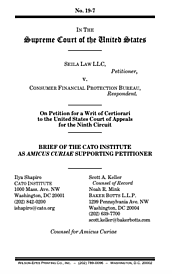Learn more about Cato’s Amicus Briefs Program.
In Federalist 47, James Madison wrote that “the accumulation of all powers, legislative, executive, and judiciary, in the same hands, whether of one, a few, or many, and whether hereditary, self-appointed, or elective, may justly be pronounced the very definition of tyranny.” Our constitutional structure is thus built on a foundation of the separation of powers. Indeed, as any Schoolhouse Rock aficionado could tell you, the legislative branch is supposed to legislate, the executive branch is supposed to enforce that legislation, and the judicial branch should interpret that legislation. But what happens when Congress places all of those powers in one agency, and then removes all of that agency’s accountability to elected officials? Worse, what happens when the power of such an agency is in the hands of one unelected individual?
This is what Congress did when it created the Consumer Financial Protections Board in 2010. First, Congress created a single director as the head of the organization, but insulated that director from presidential removal except “for cause.” This unique structure removes the president’s ability to exert control over the CFPB even though the agency is charged with enforcing laws. Furthermore, since a director serves a five-year term, a president could conceivably never appoint a new director.
Second, Congress eliminated its own power over the CFPB by granting the bureau independent access to Federal Reserve funds. Because the CFPB doesn’t need congressional approval to access these funds, there is no “power of the purse” for Congress to use to control an agency empowered to regulate the financial services industry.
Third, Congress then gave the CFPB almost unlimited power through vague statutory language. The Dodd-Frank Act grants the agency power to punish “unfair”, “deceptive,” and “abusive” practices, but also grants the CFPB’s director full discretion to define those terms. What’s even worse, no director has yet to define them terms, preferring to act on a case-by-case basis. With this vast arbitrary power, the CFPB has investigated, prosecuted, and punished people, a glaring violation of due process.
This is why Cato has filed a brief urging the Supreme Court to rule on the constitutionality of the CFPB, as we have before. (We also previously filed twice in the lower courts arguing that it’s not.) The high court has an obligation to defend our separation of powers. If the Court allows the CFPB to continue as currently constituted, it will allow major violations of constitutionally protected liberty by a powerful and unaccountable federal agency.

This work is licensed under a Creative Commons Attribution-NonCommercial-ShareAlike 4.0 International License.
